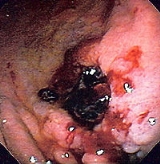
Upper gastrointestinal bleeding
Overview
Duodenum
The duodenum is the first section of the small intestine in most higher vertebrates, including mammals, reptiles, and birds. In fish, the divisions of the small intestine are not as clear and the terms anterior intestine or proximal intestine may be used instead of duodenum...
to the diaphragm
Thoracic diaphragm
In the anatomy of mammals, the thoracic diaphragm, or simply the diaphragm , is a sheet of internal skeletal muscle that extends across the bottom of the rib cage. The diaphragm separates the thoracic cavity from the abdominal cavity and performs an important function in respiration...
near the splenic flexure
Splenic flexure
The splenic flexure is a sharp bend between the transverse and the descending colon in the left upper quadrant of humans. The left colic flexure is near the spleen, and hence called the splenic flexure. There are two colic flexures in the transverse colon — the other being the hepatic...
of the colon
Colon (anatomy)
The colon is the last part of the digestive system in most vertebrates; it extracts water and salt from solid wastes before they are eliminated from the body, and is the site in which flora-aided fermentation of unabsorbed material occurs. Unlike the small intestine, the colon does not play a...
.
Upper GI bleeds are considered medical emergencies, and require admission to hospital
Hospital
A hospital is a health care institution providing patient treatment by specialized staff and equipment. Hospitals often, but not always, provide for inpatient care or longer-term patient stays....
for urgent diagnosis and management. Due to advances in medications and endoscopy
Endoscopy
Endoscopy means looking inside and typically refers to looking inside the body for medical reasons using an endoscope , an instrument used to examine the interior of a hollow organ or cavity of the body. Unlike most other medical imaging devices, endoscopes are inserted directly into the organ...
, upper GI hemorrhage is now usually treated without surgery.
Patients with upper GI hemorrhage often present with hematemesis
Hematemesis
Hematemesis or haematemesis is the vomiting of blood. The source is generally the upper gastrointestinal tract. Patients can easily confuse it with hemoptysis , although the latter is more common.-Signs:...
, coffee ground vomiting
Coffee ground vomiting
Coffee ground vomitus refers to a particular appearance of vomit. Blood contains iron within heme molecules in red blood cells. When this iron has been exposed to gastric acid for some time, it becomes oxidized. This reaction causes the vomitus to look like ground coffee. Coffee-ground vomitus is...
, melena
Melena
In medicine, melena or melaena refers to the black, "tarry" feces that are associated with gastrointestinal hemorrhage. The black color is caused by oxidation of the iron in hemoglobin during its passage through the ileum and colon.-Melena vs...
, or hematochezia
Hematochezia
Hematochezia is the passage of fresh blood per anus, usually in or with stools . Hematochezia is commonly associated with lower gastrointestinal bleeding, but may also occur from a brisk upper GI bleed...
(maroon coloured stool) if the hemorrhage is severe.
Unanswered Questions
Discussions

